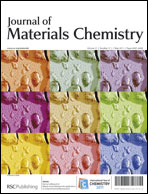Ba1−xDyxTi1−xScxO3 ceramics, 0 ≤ x ≤ 0.075, were prepared and the influence of Dy and Sc co-doping on the ferroelectric, electrical and structural properties of BaTiO3 (BT) investigated. A solid solution limit of x ≈ 0.05 was established using X-ray diffraction, and all compositions x ≤ 0.05 were tetragonal at room temperature. Fixed-frequency capacitance measurements showed the temperature of the cubic to tetragonal phase transition, TC, decreased non-linearly with increasing x and the associated permittivity peak broadened, with frequency-dependent ‘relaxor’-type behaviour observed for cubic x = 0.075. In addition, the magnitude of the relative permittivity at TC showed a negative dependence on x, decreasing from ∼11 700 for x = 0 to ∼6950 for x = 0.05. In contrast to the non-linear decrease in TC, the tetragonal to orthorhombic and orthorhombic to rhombohedral phase transition temperatures decreased linearly at rates of ∼40 and ∼28 °C mol%−1 of DyScO3, respectively. The effect on the ferroelectric properties of BT was to quadruple the coercive field, from ∼0.9 kV cm−1 for x = 0 to ∼4.4 kV cm−1 for x = 0.025, without affecting the remnant polarisation, ∼10 to 11 µC cm−2 for x = 0 to 0.025. Finally, the non-linear decrease in TC is discussed in terms of the contributions of the mean size and statistical variance of the cations on the A and B sites of the perovskite, ABO3, lattice and the replacement of Ti4+ with Sc3+ cations.


 Please wait while we load your content...
Please wait while we load your content...